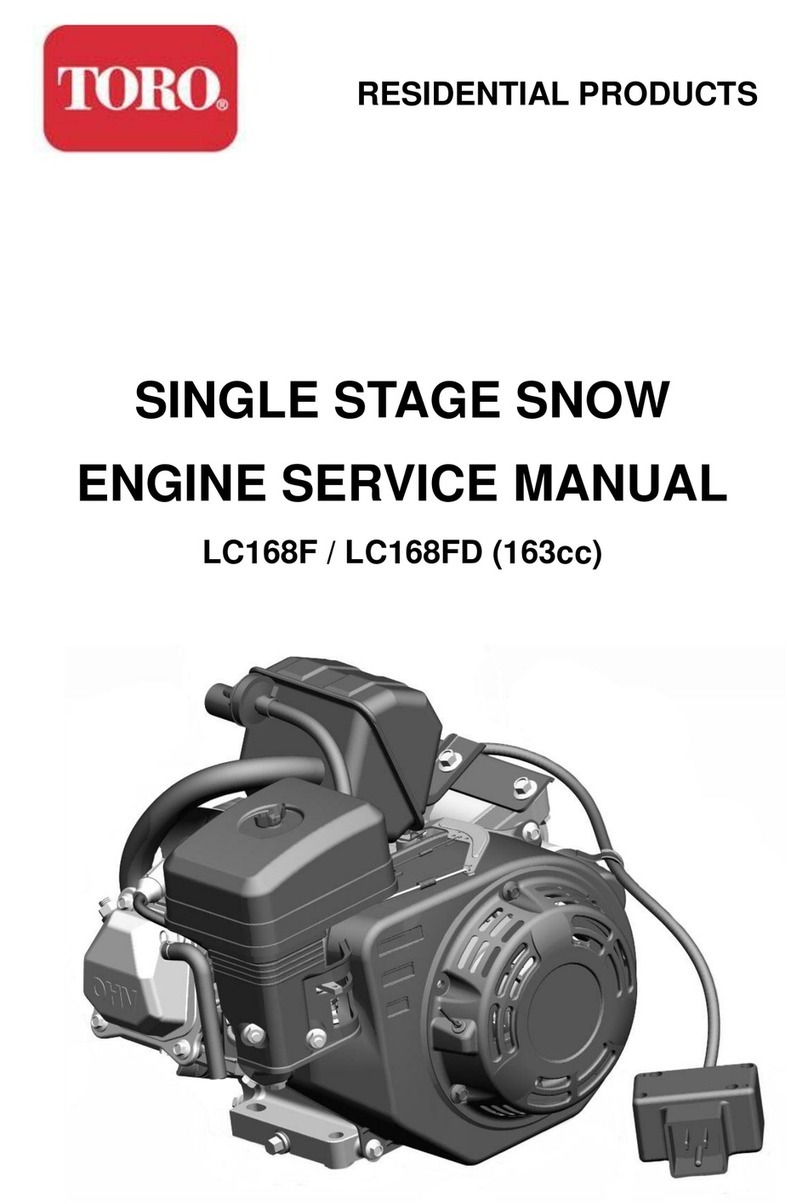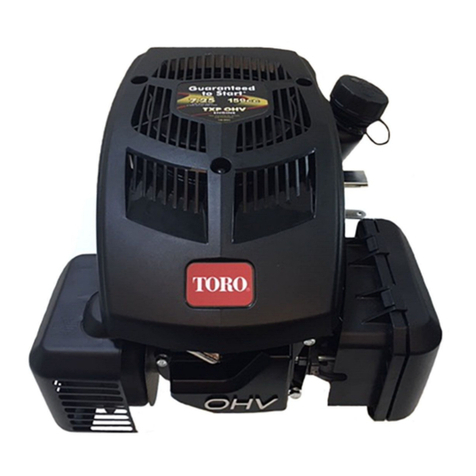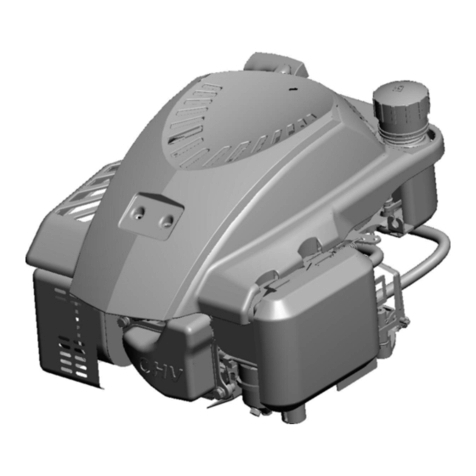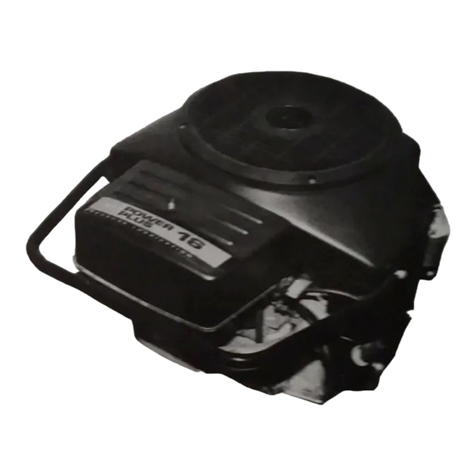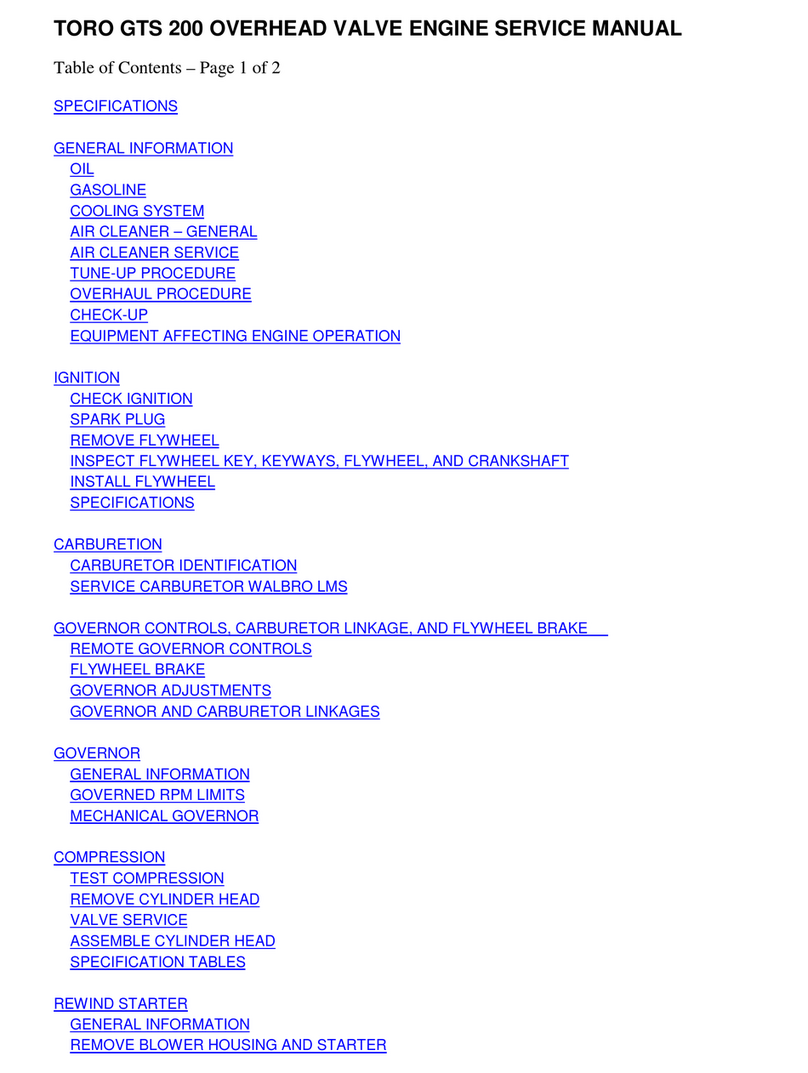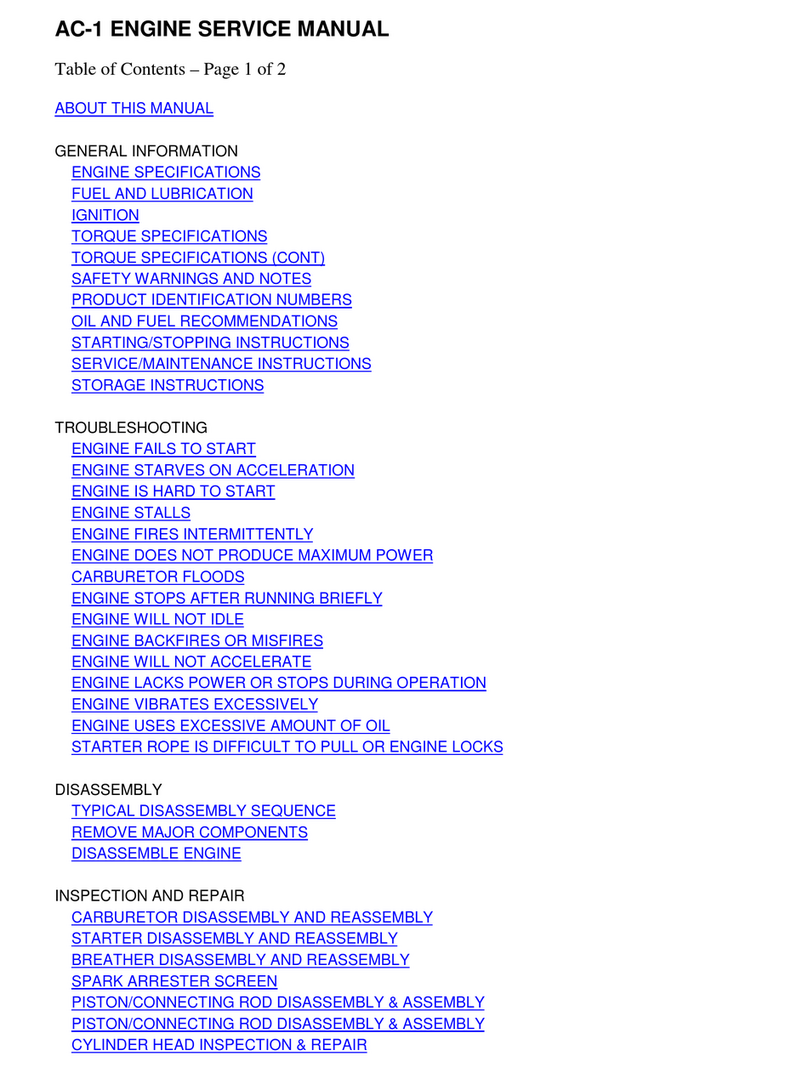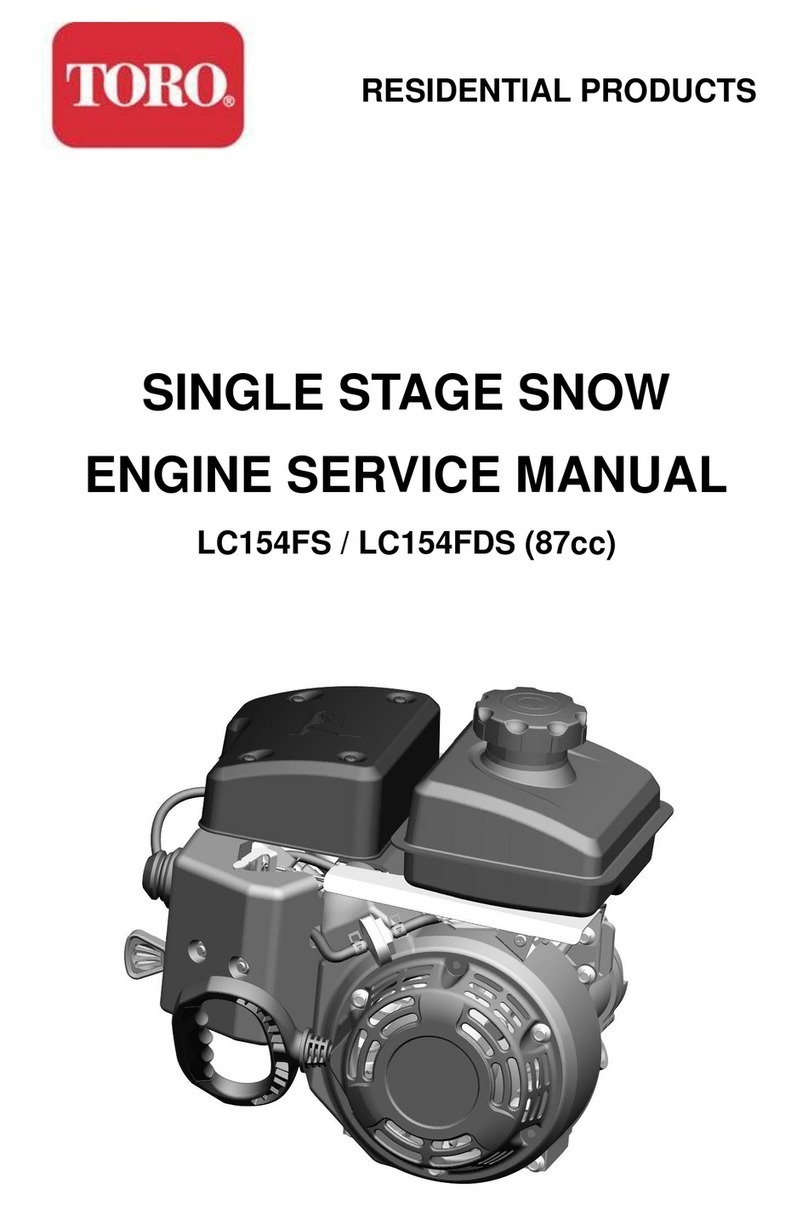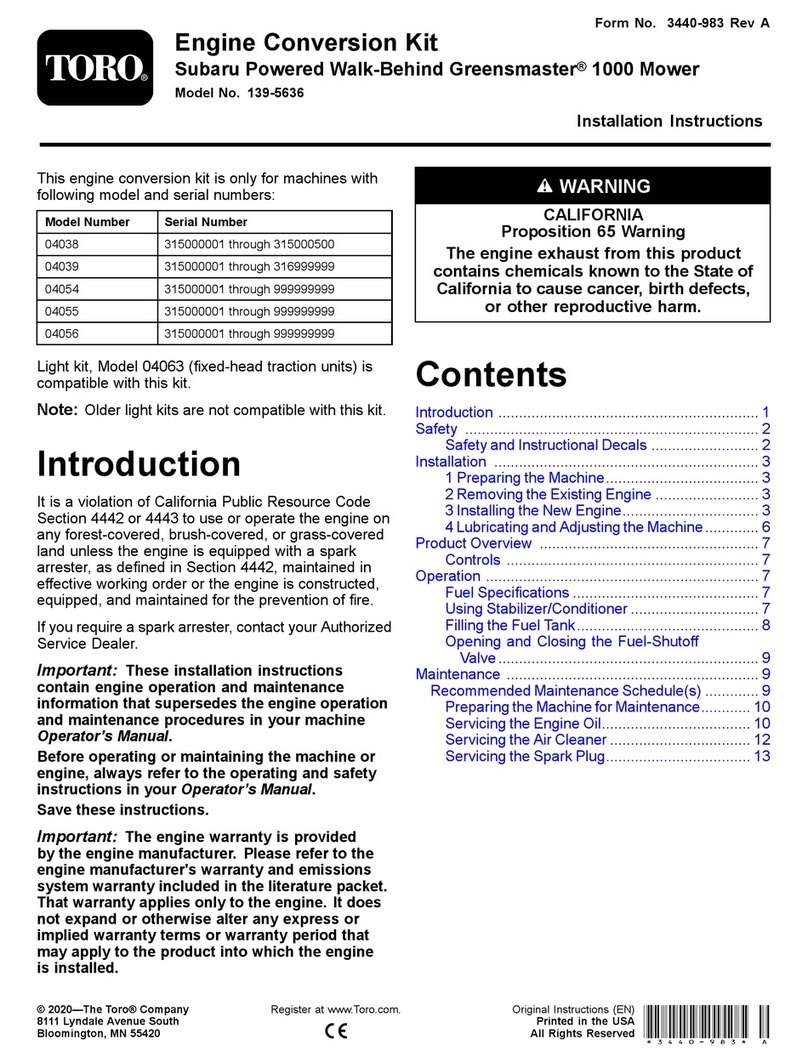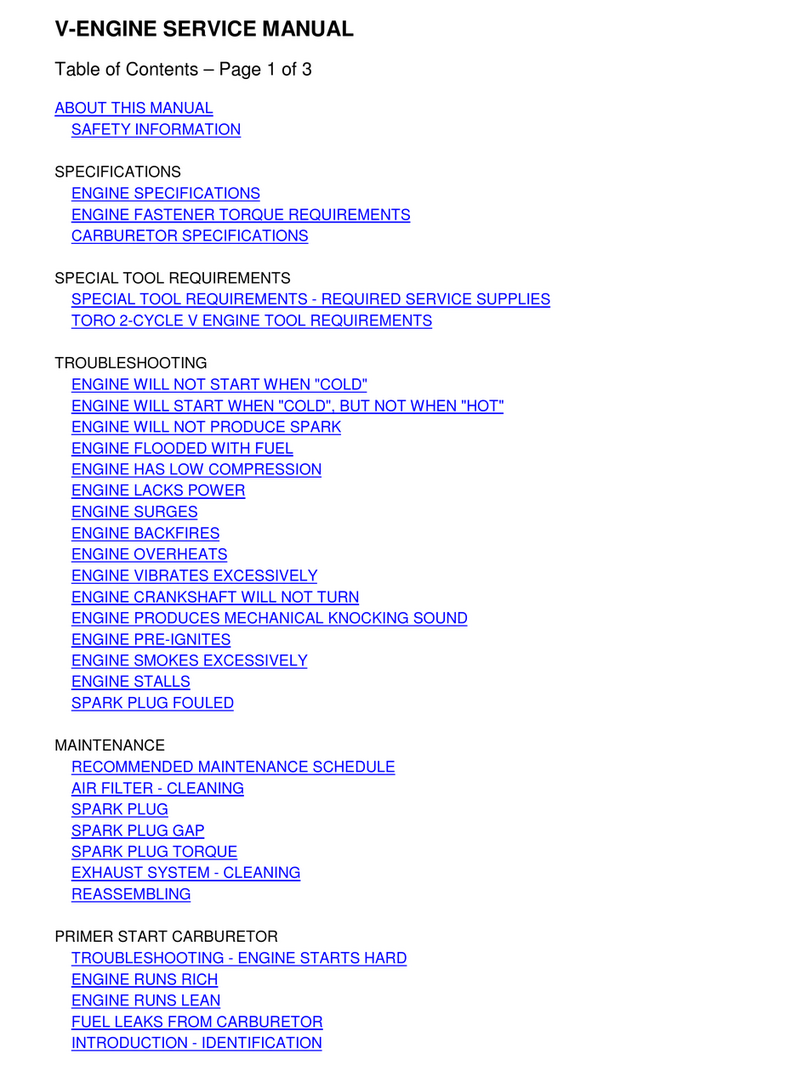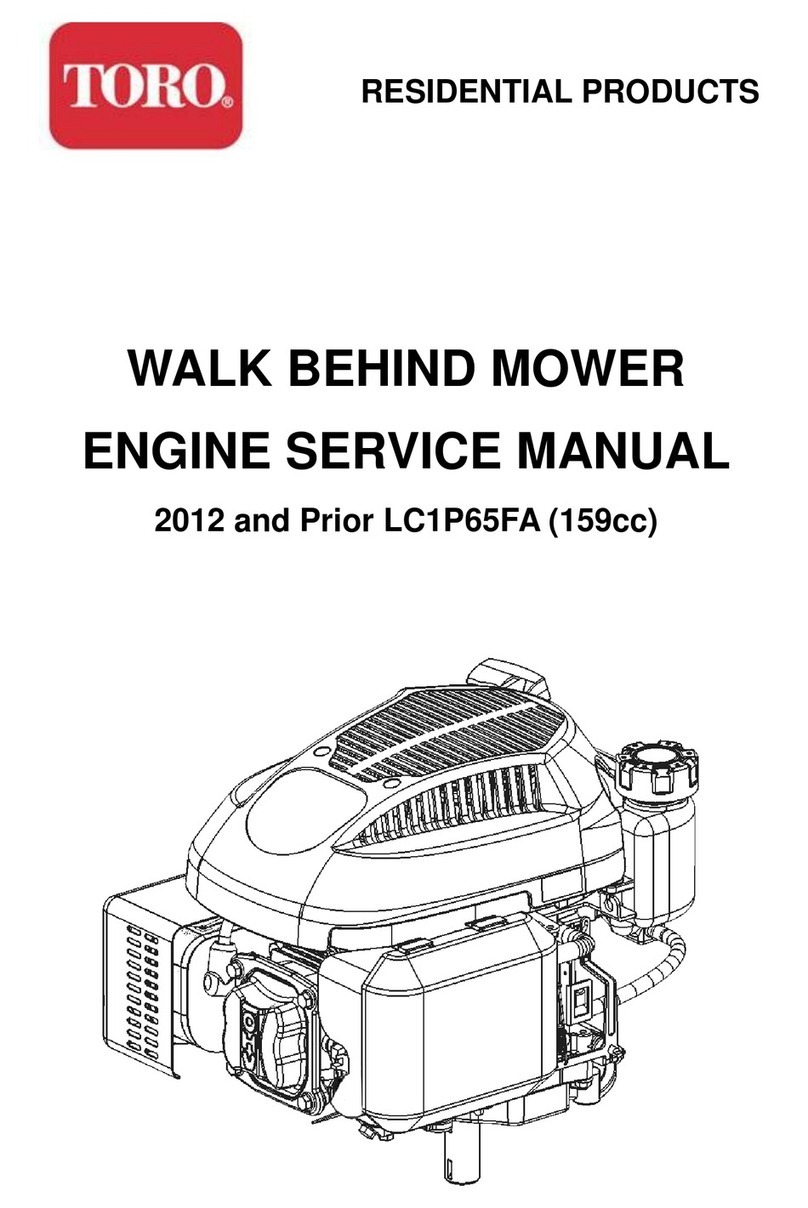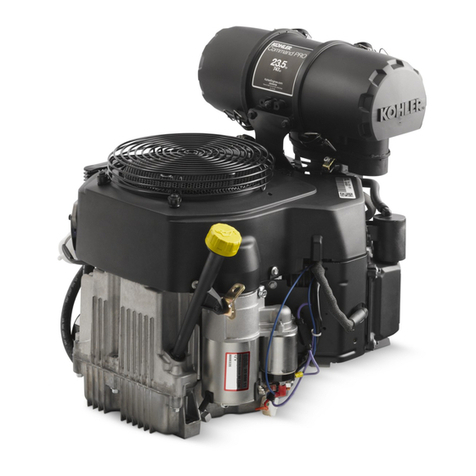Toro 303447 Operating instructions

C
o
S
m
(Re
v
o
mme
r
m
all E
n
v
. 6-12)
r
cial E
q
ng
ine
T
q
uip
m
T
roub
l
m
ent S
e
l
eshoo
t
e
rvice
T
t
in
g
T
raini
n
ng

Program Study Workbook
To The Technician: The following Program Study Workbook is designed to enhance
your understanding of small engine operation and troubleshooting.
The format is designed to increase your comprehension of important concepts and
material that are addressed in the manual.
This Service Training material should also be utilized as future reference materials to be
used one your return back at your workplace.
If you still have questions or want further explanations/clarifications, talk with other
attendees here, and/or the Training Instructor for additional explanation or discussion.
Make the most productive use of your time in this program. The clearer the
understanding you have of the information provided the more effective you become to
your employer.
The Toro Company © 2012 The Toro Company
8111 Lyndale Ave South All Rights Reserved
Bloomington, MN 55068 U.S.A.
Printed in the U.S.A.

GoodafternoonandonbehalfoftheToroCompany,
thanksforattendingthisinformationalsessiononSmall
EngineTroubleshooting.
Ifthroughthecourseofthispresentation,youhaveany
questionspleasefeelfreetoask.
Thissessionisforyouandnooneshouldleavewithout
gettingtheirquestionsasked.
Smallenginesareanimportantcomponentofmanyof
themachinesthatareneededtomaintainturfareasand
performothermaintenancejobs.
Smallenginesareveryreliableandwithpropercareand
maintenancewilllastalongtime
However,whiletheyaredependablecomponents,when
theydonotperformasneeded,theycanbeoneofthe
mostfrustratingdevicesinourselectionoftoolsand
machines.

Themostcommoncomplaintaboutsmallenginesisthat
they“WONTSTART”
Thesecondmostcommoncomplaintisthatitruns,but
runspoorly.
Inthisprogramwewilldiscusswhatisneededforthese
enginestostart,whatisneededfromthemtorun
properlyandwhattestsandtroubleshootingstepscanbe
usedwheneitherofthesetwosituationsare
encountered.
Let'sexaminehowtoidentifytheproblemyoumayface
withasmallengine.
Ifyouhaveano‐startissueorapoorperformanceissue,
therearesomeFactsthatweneedtounderstandwhen
troubleshootingtheseengines.
WewilllookattheFACTS
F—Fuel
A–Air
C–Compression
T–Timing
S–Spark
Fortheenginetorunproperlyweneedtohave,Fuel,Air,
Compression,Timing&Spark.
Thesewillbediscussedinmoredepthlaterinthis
program.

Tobegin,weneedtoidentifytheenginetogetthecorrect
enginespecs,testingspecsandadjustmentinformation.
Theenginewillnormallyhavean“EngineIdentification”
numberontheengine.
Itmaybeontheenginehousing,onthevalvecoveroron
anenginesideplate.
Thesenumbersmayincludeamodel,type,andcode
BriggsandStrattonforexample,providethefollowing
informationthroughtheirnumberingsystem.
Modelprovidesengineconfigurationinformation.
Typelistspecificparts,paintcolor,OEMinformation.
Codeprovidesspecificmanufacturingdateandplant
information.

ThisisanexampleofabasicBriggs&Strattonenginenumber.
Model303447Type1234‐01Code01061201
A
Cubic Inch
Displacement
B
Basic Design
Series
C
Crankshaft, Carburetor,
Governor
D
PTO Bearing, Reduction Gear,
Auxiliary Drive, Lubrication
6
8
9
10
11
12
13
16
17
18
19
22
23
24
25
26
28
29
30
32
35
40
42
46
0-9
A-Z 0 - Horizontal Shaft, Diaphragm
Carburetor, Pneumatic Governor
1 - Horizontal Shaft, Vacu-Jet
Carburetor, Pneumatic Governor
2 - Horizontal Shaft, Pulsa-Jet
Carburetor, Pneumatic or
Mechanical Governor
3 - Horizontal Shaft, Flo-Jet
Carburetor, Pneumatic Governor
4 - Horizontal Shaft, Vacu-Jet
Carburetor, Mechanical Governor
5 - Vertical Shaft, Vacu-Jet
Carburetor, Pneumatic or
Mechanical Governor
6 - Vertical Shaft
7 - Vertical Shaft, Flo-Jet
Carburetor, Pneumatic or
Mechanical Governor
8 - Vertical Shaft, Flo-Jet
Carburetor, Mechanical Governor
9 - Vertical Shaft, Pulsa-Jet
Carburetor, Pneumatic or
Mechanical Governor
0 - Plain Bearing / DU, Non-
Flange Mount
1 - Plain Bearing, Flange
Mounting
2 - Sleeve Bearing
Flange, Mounting, Splash Lube
3 - Ball Bearing, Flange
Mounting, Splash Lube
4 - Ball Bearing, Flange
Mounting, Pressure Lubrication
on Horizontal Shaft
5 - Plain Bearing, Gear Reduction
(6 to 1), CW Rotation, Flange
Mounting
6 - Plain Bearing, Gear Reduction
(6 to 1), CW Rotation, Flange
Mounting
7 - Plain Bearing, Pressure
Lubrication on Vertical Shaft
8 - Plain Bearing, Auxiliary Drive
(PTO) Perpendicular to
Crankshaft
9 - Plain Bearing, Auxiliary Drive
(PTO) Parallel to Crankshaft

Usingthepreviouschart,wecanseethatthe303447refertothefollowingenginespec.
30CubicInch,designseries3,horizontalcrankshaft,ballbearing,pressurelubricatedenginewithan
electricstartedandgeardrivealternator.
ThetypenumberlistspecificationnormallyrelatedtotheOEMoptionsandrequirement.
Thisincludedtheenginepaintcolor,governedspeedandOEMinformation.
Thecodetellsusthatthisenginewasbuilt,June12,2001online1,plant1.
Allofthisinformationisneededtoproperlytest,adjustandrepairtheengine.

FortheenginetorunthereareEight(8)eventsarerequiredfora2or4cycleenginetooperate.
First,Airisdrawnintothecylinder
Thecorrectamountoffuelismeteredintotheair
Theairandfuelaremixed
Theairfuelmixtureiscompressed
Thesparkplugfiresstartingcombustion
Combustioncausesarapidriseintemperature.Theincreasedtemperaturecausespressuretoincrease
whichproducesaforceonthepiston.
Theconnectingrodandcrankshaftconvertsthelinearmotiontorotarymotion.
Theburntgasesareexpelledfromtheengine.
Donotconfusetheseeventswiththefourstrokes(events)ofafourcycleengine.

Everyonehasheardofthefourstrokeorfourcycleengine.
Afour‐strokeengine,alsoknownasfour‐cycle,isaninternalcombustionengineinwhichthepiston
completesfourseparatestrokes—intake,compression,power,andexhaust—duringtwoseparate
revolutionsoftheengine'scrankshaft,andonesinglecombustioncycle.

INTAKEstroke:ontheintakeorinductionstrokeofthepiston,thepistondescendsfromthetopofthe
cylindertothebottomofthecylinder,reducingthepressureinsidethecylinder.Amixtureoffuelandair,
isforcedbyatmosphericpressureintothecylinderthroughtheintakeport.Theintakevalve(s)then
close.Thevolumeofair/fuelmixturethatisdrawnintothecylinder,relativetothevolumeofthe
cylinderiscalled,thevolumetricefficiencyoftheengine.
Detail
PistonmovesfromTDCtoBDC
Intakevalveopen
Exhaustvalveclosed
Pistonmovementcausesanareaoflowpressuretodevelopinthecombustionchamber.
Higherambientatmosphericpressureforcesairthroughtheintakesystem.
Ingascarburetedenginetheairpicksupthefuelasitpassesthroughthecarburetor.
Ingasfuelinjectedenginesthegasisaddedtotheairthroughaninjector.
InDieselenginesthefuelisinjectedintothecylinderattheendofthecompressionstroke.
180degreesofrotation
Anythingthatrestrictstheflowofairwillreduceengineperformance.

COMPRESSIONstroke:withbothintakeandexhaustvalvesclosed,thepistonreturnstothetopofthe
cylindercompressingtheair,orfuel‐airmixtureintothecombustionchamberofthecylinderhead.
Detail
PistonmovesfromBDCtoTDC
Intakevalveclosed
Exhaustvalveclosed
Pistonmovementreducesthevolumeofthecombustionchamber‐‐increasespressure.
Pressureofcompression=60to80psi.
Anypressurethatescapesreducestheperformanceoftheengine.
360degreesofrotation

Inorderfortheenginetorun,theairandfuelmixtureiscompressedinthecylinder.Thisincreasesthe
densityofthefuelairmixtureandallowsforamoreefficientcombustionprocess,andhigherpower
output.
CompressionratioisacomparisonbetweenthevolumeofthecylinderatBDCtothevolumeofthe
cylinderatTDC.
Ratiosof6to8:1arecommonforgasolineenginesand18to20:1forDieselengines.

POWERstroke:thisisthestartofthesecondrevolutionof
theengine.WhilethepistonisclosetoTop DeadCenter,
thecompressedair–fuelmixtureinagasolineengineis
ignited,usuallybyasparkplug,orfuelisinjectedintothe
dieselengine,whichignitesduetotheheatgeneratedin
theairduringthecompressionstroke.Theresulting
massivepressurefromthecombustionofthecompressed
fuel‐airmixtureforcesthepistonbackdowntoward
bottomdeadcenter.
Detail
PistonmovesfromTDCtoBDC
Intakevalveclosed
Exhaustvalveclosed
Rapidburningcausesrapidriseintemperature.
Rapidriseintemperaturecausesincreasedpressure.
Pressureinducesaforceonthepiston.
Forceonpistonproducestorqueoncrankshaft.
540degreesrotation
EXHAUSTstroke:duringtheexhauststroke,thepiston
onceagainreturnstotopdeadcenterwhiletheexhaust
valveisopen.Thisactionevacuatestheburntproductsof
combustionfromthecylinderbyexpellingthespentfuel‐
airmixtureoutthroughtheexhaustvalve(s).
Detail
PistonmovingfromBDCtoTDC.
Intakevalveclosed
Exhaustvalveopen
Wastegassesareexpelledfromthecylinder.
720degreesofrotation

Therearesomespecificcharacteristicsrelatedtoafour
cycleengine
Twocompleterevolutionsofthecrankshaftpercycle
resultsinapowerimpulseeveryotherrevolution.
Theseenginesaremorepopularthan2cycle
Theydorequiremorepartsthat2cycle.
Lessexhaustemissionsthan2cycle.
Typicallubricationsystemrestrictsangleofoperationdue
toeithersplashlubefromthesump,orpressure
lubricated,pullingoilfromthesump.
Theyarealsonormallymoredurablethan2cycle.

Inthe2strokecyclealleighteventsoccurintwostrokes,onerevolutionofthecrankshaft.
Thesparkplugfiresandthepistonmovesawayfromthecylinderhead.
Simultaneouslytheair‐fuel‐oilinthecrankcaseiscompressed.
Asthepistonreachesthebottomofthestroketheexhaustportisexposed.
Cylinderpressurecausesgassestoflowouttheport.
Furthermovementofthepistonandtheintakeportisexposed
Crankcasepressurecausesair‐fuel‐oiltoflowintothecombustionchamber.
Asthepistonmovestowardsthecylinderheadtheintakeandexhaustportsarecoveredandtheair‐fuel‐
oilchargeiscompressed.
Assoonastheintakeportiscovered,furtherpistonmovementcauseslowpressureinthecrankcaseand
anewchargefillsthecrankcase.

Therearesomespecificcharacteristicsrelatedtoatwo
cycleengine
Onerevolutionpercyclemeansapowerimpulseevery
revolution.
Fewerparts=lessweight
Usesscavengingtoexpelexhaustgases.
Higherfuelconsumption
Morenoise
Higheroperatingspeed
Higheroperatingtemperature
Greaterexhaustemissions
Smallsizeandweightforequalhorsepower.
Operateinmulti‐positions
Shorterexpectedlife
Earlierwementionsthe“FACTS”requiredforengine
operation.
Let'sexaminehowtoidentifytheproblemyoumayface
withasmallengine
ThiswillrequirealookattheFactsthatareneededto
maketheenginerun,andrunproperly.
Let'sbeginwithFuel.
WhenlookingatFUELthereareafewquestionstoask…
Doesithaveanyfuel?
Istheshutoffvalveclosed?
Isthefueldilutedwithwater?
AlcoholcontentofFuel?
Isthefuellineblocked?
Isthefueltankcapcloggedorunvented?
Isfuelinthecarburetor?

In recent years, small engines have run into issues
due to federally mandated changes in fuel
requirements.
This deals with the “Oxygenated” fuel that are
becoming more common in the country.
This started back in 1990 with the clean air act.
Clean Air Act 1990 requires gasoline to be modified
with oxygen additives in nonattainment zones.
Nonattainment zone: areas of the country that
exceed ozone levels.
There are Two common additives;
Alcohol
Methyl Tertiary Butyl Ether (MTBE)
Alcohol
Two types
Ethanol: distilled from grains and sugar containing
plants
Methanol: distilled from natural gas
The addition of alcohol to gasoline increases the
available oxygen during the combustion process.
Up to 10% ethanol acceptable for most small
engines.
Methanol is not normally recommended for small
engines.
MTBE
Removed from market because of health concerns.

Alcoholcontentcanplayamajorroleinperformanceissuesrelatedtosmallengines.
Theblendingofalcoholwithgasolinecaninsomeareasbeinconsistentwithalcoholcontentsometimes
beinghigherthanthedesired10%
Tocheckthealcoholcontestoffuel,thereareavarietyoftestdevicestoassistwiththis.
Thiskit,availablefromKohlerallowstheusertoquicklyandeffectivelytestfuelforalcoholcontent.
Tocheckalcoholcontent,addwatertothetester,uptothewaterline.
Thenaddgasolineuptotheneckofthetester.
Putonthecapandshake.
Thewaterwillmixwiththealcoholwhilethegasandthewaterwillremainseparated.
Setasideforacoupleminutesandthennotewherethewater/fuelseparationlineis.
Comparethatseparationlinetothelineonthetester.
Thiswillindicatethepercentageofalcoholinthefuel.
Ideallythisshouldbe10%.

Next,let'slookatAIR
Airisrequiredtoprovidetheoxygenneededfor
combustion,andtheenginealsoneedsasufficient
amountofair,forcompressiontobeadequate.
Insmallenginesthereareonlytwoareathatcanrestrict
theflowofairintotheengine.
Firstisthethrottleplateinthecarburetororintake
manifoldinfuelinjectedengines.
Theotherlocationistheairfilter.Thiscanbeanair
restrictionpointifnotproperlymaintained.
Theprimaryfunctionofanairfilteristodeliverbothhigh
airflowanddirtprotection.
Bothairflowanddirtprotectionarecriticaltoengine
performance.
Thebasictypesofairfiltersare.
Oiled‐foam,thisisafoamtypematerialwhichisoiledto
capturedirtparticlesandkeepsthemfromenteringthe
engine.
Thesetypesoffiltersarenormallycleanedandre‐oiledas
amaintenanceprocedure
Papertypefiltersusedapleatedpaperelementwith
holesofaspecificsizedesignedtocapturedirtparticles
alsoofaspecificsize.
Thesecanalsobecleanedasamaintenanceprocedure.
Dual‐elementfiltersareacombinationofbothtypes.
Theyconsistofapaperelementcoveredbyanoiled‐foam
element.

AirCleanerService–
Airfiltersshouldbecleanedpermanufactures
recommendations
Oiled‐Foamtypeelementscanbecleanedusingsoapand
water.Addasmallamountofoilandsqueezetosaturate
theelement.
Papertypeelementscanbecleanedbytappinggentlyon
aflatsurfaceorbyusingcompressedair.
Someenginemanufacturesmaynotrecommendusingcompressedairwhencleaningfilters.Ifyou
choosetoyoucompressedairtocleanapaperelementfilter,itisrecommendedthatthefilterbe
cleanedwithlowpressureair.
Thisreducesthelikelihoodthatthepaperelementisdamagedduringthecleaningprocess.
Arecommendationistoattachanairpressureregulatortothehosethatisusedforfiltercleaning.
Settingtheregulatorfor10‐20PSIwillnormallydoasufficientjobofcleaningwithoutriskingdamageto
theelement.
ThenextitemtolookatisCompression.
Other Toro Engine manuals
Popular Engine manuals by other brands
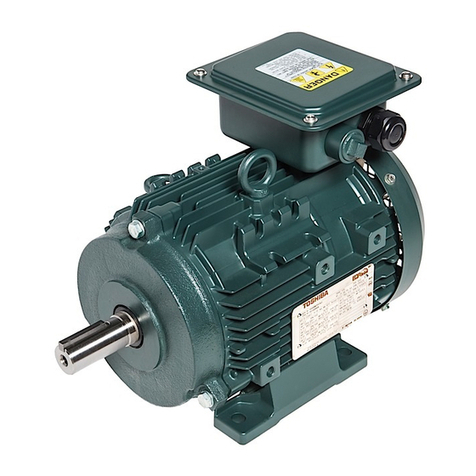
Toshiba
Toshiba EQP Global IEC Series Installation Instructions and Maintenance Manual

Iveco Motors
Iveco Motors NEF Series Use and maintenance

Lombardini
Lombardini 15 LD 500 Use and maintenance

Selve
Selve SEE-NHK quick start guide
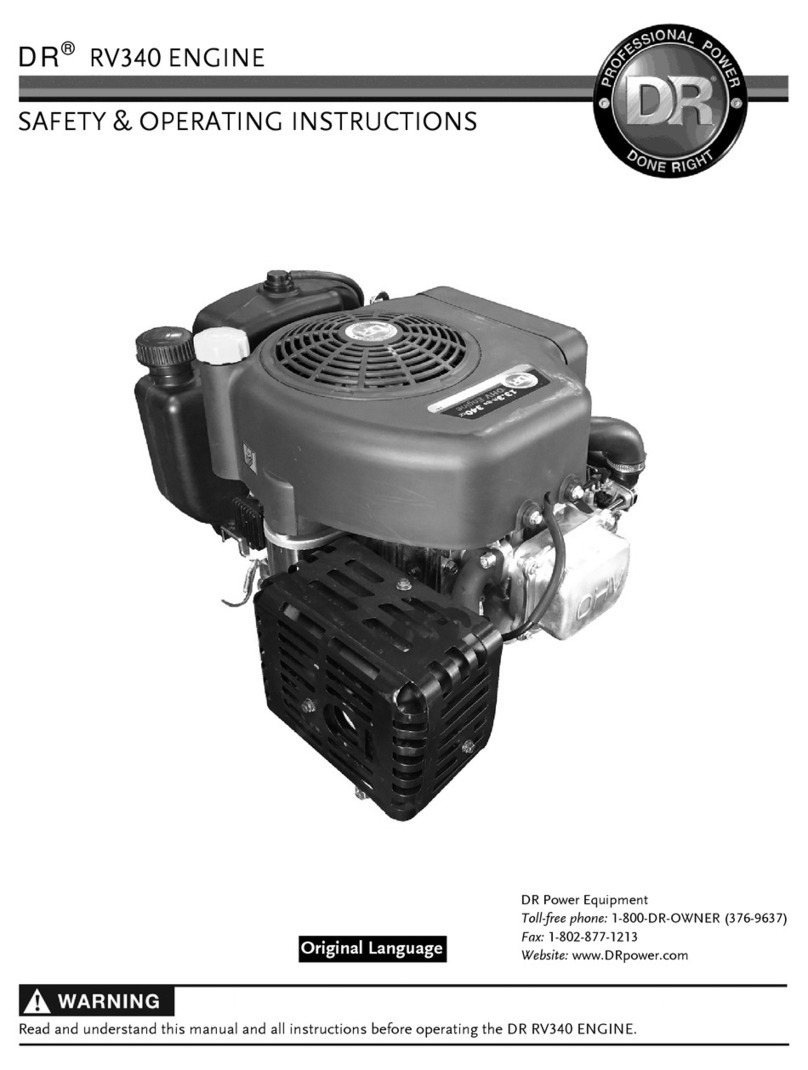
DR
DR RV340 Safety & Operating Instructions
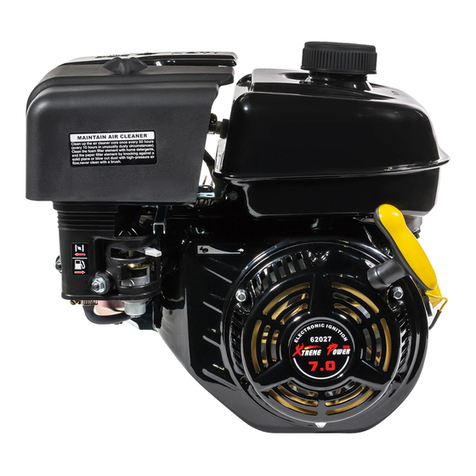
Xtreme Power
Xtreme Power 62027 owner's manual

WEG
WEG W21 instruction manual

Briggs & Stratton
Briggs & Stratton Vanguard 540000 Series Operator's manual
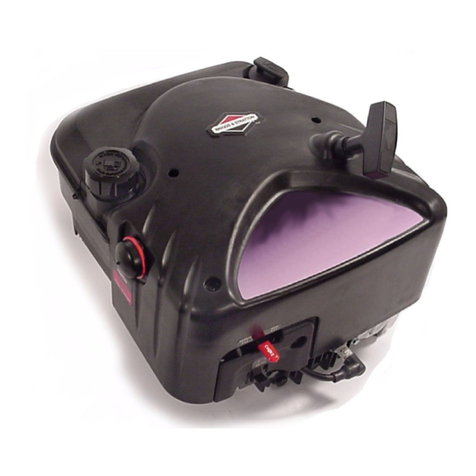
Briggs & Stratton
Briggs & Stratton PowerBuilt Snow 120000 Series Operating & maintenance instructions
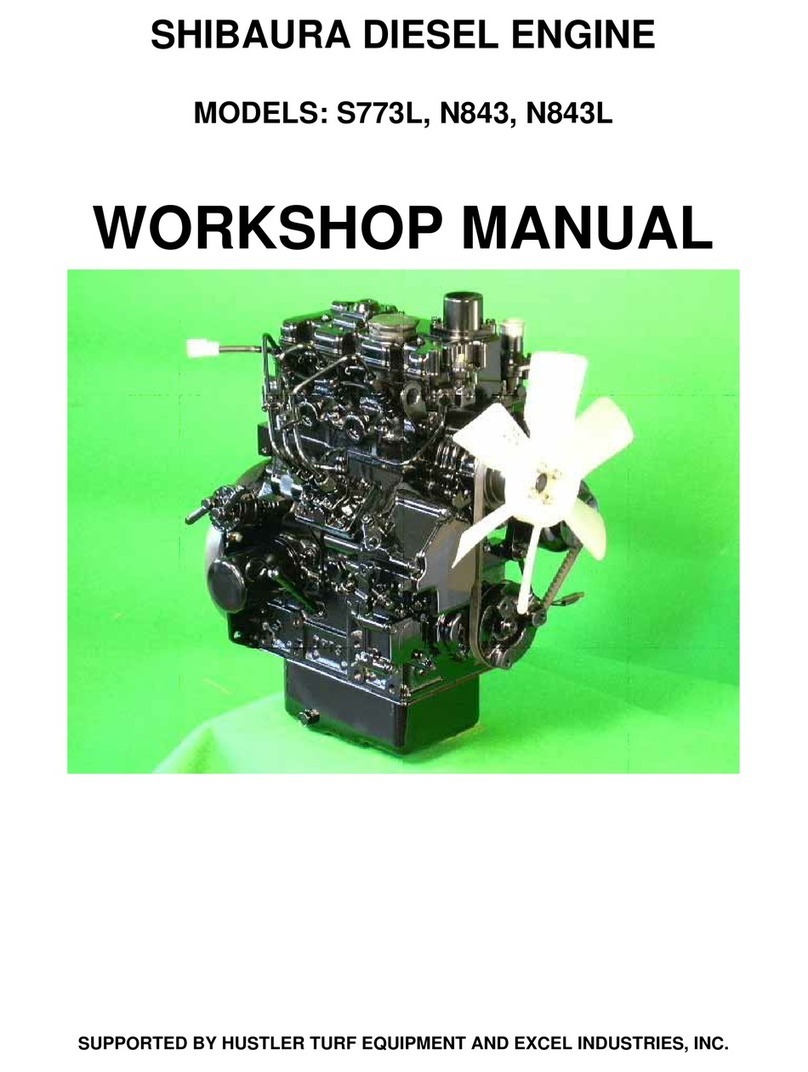
Shibaura
Shibaura N843L Workshop manual

Coulisse
Coulisse CM-01 manual
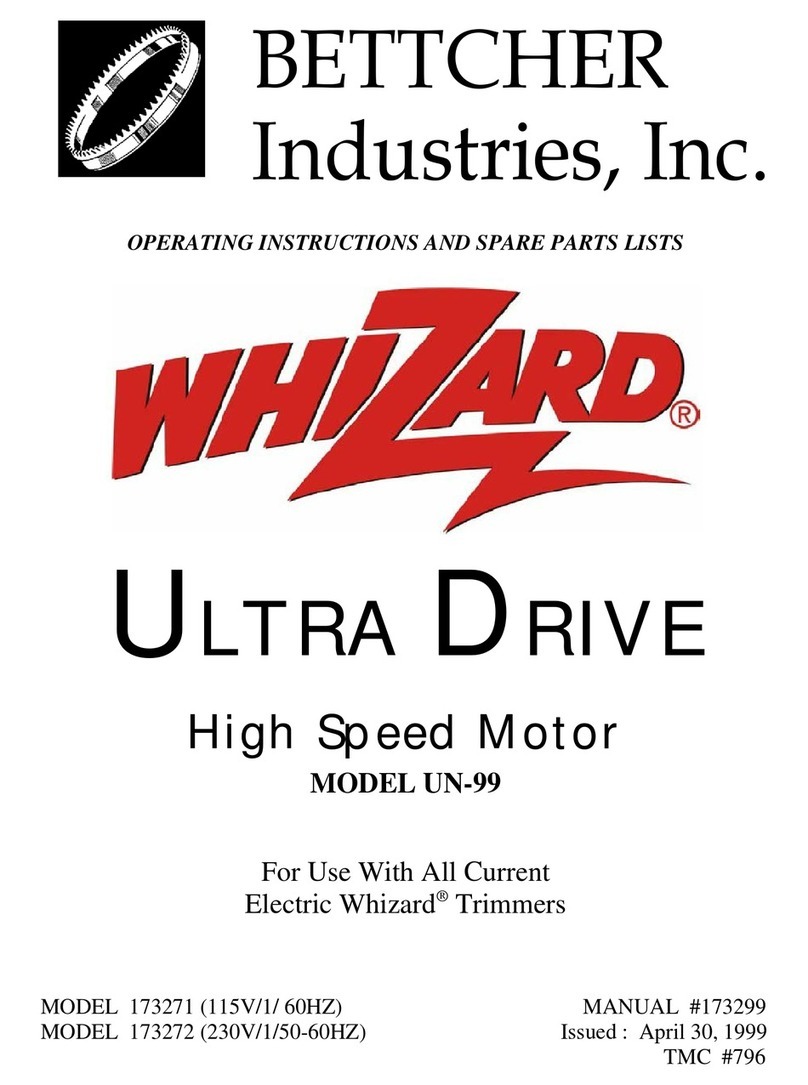
Bettcher
Bettcher Ultra Drive UN-99 Operating instructions and spare parts lists



